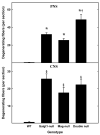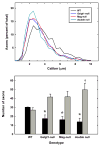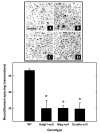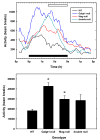Myelin-associated glycoprotein and complementary axonal ligands, gangliosides, mediate axon stability in the CNS and PNS: neuropathology and behavioral deficits in single- and double-null mice
- PMID: 15953602
- PMCID: PMC1852502
- DOI: 10.1016/j.expneurol.2005.04.017
Myelin-associated glycoprotein and complementary axonal ligands, gangliosides, mediate axon stability in the CNS and PNS: neuropathology and behavioral deficits in single- and double-null mice
Abstract
Complementary interacting molecules on myelin and axons are required for long-term axon-myelin stability. Their disruption results in axon degeneration, contributing to the pathogenesis of demyelinating diseases. Myelin-associated glycoprotein (MAG), a minor constituent of central and peripheral nervous system myelin, is a member of the Siglec family of sialic acid-binding lectins and binds to gangliosides GD1a and GT1b, prominent molecules on the axon surface. Mice lacking the ganglioside biosynthetic gene Galgt1 fail to express complex gangliosides, including GD1a and GT1b. In the current studies, CNS and PNS histopathology and behavior of Mag-null, Galgt1-null, and double-null mice were compared on the same mouse strain background. When back-crossed to >99% C57BL/6 strain purity, Mag-null mice demonstrated marked CNS, as well as PNS, axon degeneration, in contrast to prior findings using mice of mixed strain background. On the same background, Mag- and Galgt1-null mice exhibited quantitatively and qualitatively similar CNS and PNS axon degeneration and nearly identical decreases in axon diameter and neurofilament spacing. Double-null mice had qualitatively similar changes. Consistent with these findings, Mag- and Galgt1-null mice had similar motor behavioral deficits, with double-null mice only modestly more impaired. Despite their motor deficits, Mag- and Galgt1-null mice demonstrated hyperactivity, with spontaneous locomotor activity significantly above that of wild type mice. These data demonstrate that MAG and complex gangliosides contribute to axon stability in both the CNS and PNS. Similar neuropathological and behavioral deficits in Galgt1-, Mag-, and double-null mice support the hypothesis that MAG binding to gangliosides contributes to long-term axon-myelin stability.
Figures










Similar articles
-
Myelin-associated glycoprotein (Siglec-4) expression is progressively and selectively decreased in the brains of mice lacking complex gangliosides.Glycobiology. 2004 Sep;14(9):851-7. doi: 10.1093/glycob/cwh107. Epub 2004 Jun 2. Glycobiology. 2004. PMID: 15175257
-
Brain gangliosides: functional ligands for myelin stability and the control of nerve regeneration.Biochimie. 2001 Jul;83(7):677-82. doi: 10.1016/s0300-9084(01)01308-6. Biochimie. 2001. PMID: 11522397 Review.
-
Brain gangliosides in axon-myelin stability and axon regeneration.FEBS Lett. 2010 May 3;584(9):1741-7. doi: 10.1016/j.febslet.2009.10.011. Epub 2009 Oct 12. FEBS Lett. 2010. PMID: 19822144 Free PMC article. Review.
-
Gangliosides are neuronal ligands for myelin-associated glycoprotein.Proc Natl Acad Sci U S A. 1996 Jan 23;93(2):814-8. doi: 10.1073/pnas.93.2.814. Proc Natl Acad Sci U S A. 1996. PMID: 8570640 Free PMC article.
-
Glial Sulfatides and Neuronal Complex Gangliosides Are Functionally Interdependent in Maintaining Myelinating Axon Integrity.J Neurosci. 2019 Jan 2;39(1):63-77. doi: 10.1523/JNEUROSCI.2095-18.2018. Epub 2018 Nov 16. J Neurosci. 2019. PMID: 30446529 Free PMC article.
Cited by
-
Gangliosides of the Vertebrate Nervous System.J Mol Biol. 2016 Aug 14;428(16):3325-3336. doi: 10.1016/j.jmb.2016.05.020. Epub 2016 May 31. J Mol Biol. 2016. PMID: 27261254 Free PMC article. Review.
-
Lipid rafts and neurodegeneration: structural and functional roles in physiologic aging and neurodegenerative diseases.J Lipid Res. 2020 May;61(5):636-654. doi: 10.1194/jlr.TR119000427. Epub 2019 Dec 23. J Lipid Res. 2020. PMID: 31871065 Free PMC article. Review.
-
A novel system to accelerate the progression of nerve degeneration in transgenic mouse models of neuropathies.Exp Neurol. 2012 Sep;237(1):153-9. doi: 10.1016/j.expneurol.2012.05.021. Epub 2012 Jun 9. Exp Neurol. 2012. PMID: 22688009 Free PMC article.
-
An introduction to sphingolipid metabolism and analysis by new technologies.Neuromolecular Med. 2010 Dec;12(4):306-19. doi: 10.1007/s12017-010-8132-8. Epub 2010 Aug 3. Neuromolecular Med. 2010. PMID: 20680704 Free PMC article. Review.
-
Mammalian-Specific Central Myelin Protein Opalin Is Redundant for Normal Myelination: Structural and Behavioral Assessments.PLoS One. 2016 Nov 17;11(11):e0166732. doi: 10.1371/journal.pone.0166732. eCollection 2016. PLoS One. 2016. PMID: 27855200 Free PMC article.
References
-
- Bartsch S, Montag D, Schachner M, Bartsch U. Increased number of unmyelinated axons in optic nerves of adult mice deficient in the myelin-associated glycoprotein (MAG) Brain Res. 1997;762:231–234. - PubMed
-
- Bjartmar C, Kidd G, Mork S, Rudick R, Trapp BD. Neurological disability correlates with spinal cord axonal loss and reduced N-acetyl aspartate in chronic multiple sclerosis patients. Ann Neurol. 2000;48:893–901. - PubMed
-
- Bjartmar C, Wujek JR, Trapp BD. Axonal loss in the pathology of MS: consequences for understanding the progressive phase of the disease. J Neurol Sci. 2003;206:165–171. - PubMed
-
- Bjartmar C, Yin X, Trapp BD. Axonal pathology in myelin disorders. J Neurocytol. 1999;28:383–395. - PubMed
-
- Bruck W, Stadelmann C. Inflammation and degeneration in multiple sclerosis. Neurol Sci. 2003;24:S265–S267. - PubMed
Publication types
MeSH terms
Substances
Grants and funding
LinkOut - more resources
Full Text Sources
Other Literature Sources
Molecular Biology Databases
Research Materials

